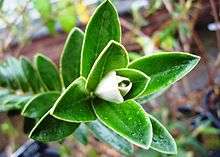Buddleja coriacea
Buddleja coriacea is a variable species endemic to the high Andes from the Cordillera Blanca in Peru to Lake Titicaca in Bolivia. It grows on dry to semi-humid rocky soils at elevations of 3,000–4,350 m,[1] where temperatures range from -3° to 15° C. and the winds are both strong and persistent.[2][3] The species was first named and described by Rémy in 1847.[1]
| Buddleja coriacea | |
|---|---|
 | |
| Buddleja coriacea foliage, Longstock Park Nursery | |
| Scientific classification | |
| Kingdom: | Plantae |
| Clade: | Tracheophytes |
| Clade: | Angiosperms |
| Clade: | Eudicots |
| Clade: | Asterids |
| Order: | Lamiales |
| Family: | Scrophulariaceae |
| Genus: | Buddleja |
| Species: | B. coriacea |
| Binomial name | |
| Buddleja coriacea | |
| Synonyms | |
| |
Description
Buddleja coriacea typically makes a densely crowned, sprawling trioecious shrub or tree, branching almost at ground level. Usually growing to less than 4 m in height in the wild, it can occasionally reach 12 m, with stems up to 40 cm in diameter; the bark is fissured.[2][1] The species is chiefly distinguished by its small, thick, leathery leaves, 1–4 cm long by 0.5–1.5 cm wide, with 3–4 mm petioles. The upper surfaces of the leaves are dark-green and glabrous, contrasting with the undersides which are covered in a cinnamon-brown indumentum. The scented inflorescences comprise 3–8 pairs of head-like cymes, 0.9–1.2 cm in diameter, of 8–12 flowers, the corollas 4.5–6 mm in length, deep yellow to orange-yellow, becoming orange-red with age. Flowering occurs throughout the year, but most commonly between December and June. Ploidy: 2n = 76 (tetraploid).[1]
Cultivation
Buddleja coriacea is cultivated in the high Andes as a field windbreak, as a source of humus for soil improvement, and as high quality, rotproof timber for use in building construction and manufacture of agricultural tools.[3] The shrub was introduced to horticulture in the UK circa 1994, and specimens are held as part of the NCCPG national collection at the Longstock Park Nursery, near Stockbridge.[4] Although not entirely hardy in the UK, the shrub can survive most winters with a modicum of protection; overwinter waterlogging regarded as a greater danger to the plant. The shrub has never been known to flower in the UK owing to either the insufficient intensity or duration of sunlight. Hardiness: USDA zone 9.[5]
Hybrids
The species is believed to commonly hybridize with B. montana and B. incana in the wild.[1]
References
- Norman, E. M. (2000). Buddlejaceae. Flora Neotropica 81. New York Botanical Garden, USA
- Jøker, D., Cruz, N., Morales, M., & Rojas, E. (2002). Buddleja coriacea Remy Seed leaflet. No. 54, Jan. 2002. BASFOR, Danido Forest Seed Centre, Humleback, Denmark.
- Arica, D. (2013). Buddleja coriacea - 'Colle', 'Kishuara'. Algunas Especies Forestales nativas Para la Zona Altoandina. (Some native forest species for the High Andes). CONDESAN (Consorcio para el Desarrollo Sostenible de la Ecorregion Andina), Lima, Peru.
- Moore, P. (2012). Buddleja List 2011-2012 Longstock Park Nursery. Longstock Park, UK.
- Stuart, D. (2006). Buddlejas. Timber Press, Oregon, USA. ISBN 978-0-88192-688-0
Further reading
- Cruz, N., Morales, M, & Rojas, E. (2000). Buddleja coriacea. Fichas Tecnicas de Especes Forestales (in Spanish). BASFOR, Bolivia.